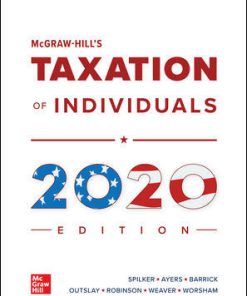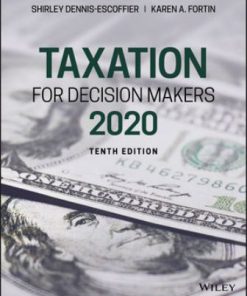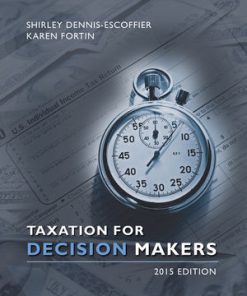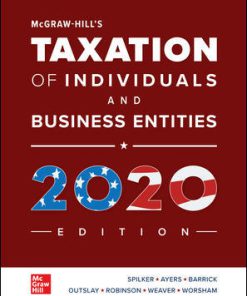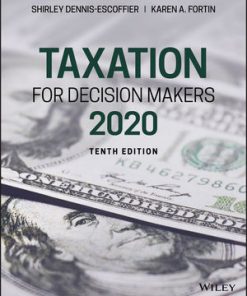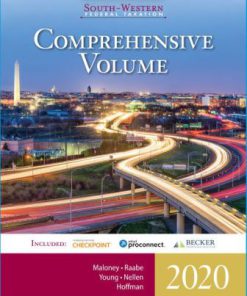Solution Manual for Taxation for Decision Makers, 2020 10th by Dennis-Escoffier
$35.00 Original price was: $35.00.$26.50Current price is: $26.50.
Solution Manual for Taxation for Decision Makers, 2020 10th by Dennis-Escoffier
Solution Manual for Taxation for Decision Makers, 2020 10th by Dennis-Escoffier

Product details:
- ISBN-10 : 1119562104
- ISBN-13 : 978-1119562108
- Author:
Taxation 2020 introduces all relevant tax topic covered in the CPA exam to undergraduate or graduate students in one-semester introductory tax courses. Offering a decision-making approach to the material, this comprehensive yet accessible text maintains the appropriate balance between concepts and specifics. Twelve concise, student-friendly chapters supply sufficient details to build upon for future careers in taxation and consulting while avoiding the minutiae rarely seen in everyday practice.
Table contents:
Part I Introduction to Taxation and Its Environment
1 An Introduction to Taxation 2
Setting the Stage—An Introductory Case 3
1.1. An Introduction to Taxes 3
1.1.1. What Is a Tax? 3
1.1.2. Evolution of the Federal Income Tax 4
1.1.3. State and Local Income Taxes 5
1.1.4. Employment Taxes 7
1.1.5. Wealth Taxes 8
1.1.6. Wealth Transfer Taxes 9
1.1.7. Consumption Taxes 10
1.1.8. Tariffs and Duties 12
1.2. Types of Tax Rate Systems 13
1.2.1. The Progressive Tax Rate System 13
1.2.2. Proportional “Flat” Tax Rate 15
1.2.3. Regressive Taxes 15
1.3. Characteristics of a Good Tax 16
1.3.1. Equity 16
1.3.2. Economy 17
1.3.3. Certainty 18
1.3.4. Convenience 18
1.4. The Taxing Units and the Basic Income Tax Model 19
1.4.1. The Basic Tax Model 20
1.4.2. Trusts and Estates 29
1.5. Choice of Business Entity 30
1.5.1. Sole Proprietorships 32
1.5.2. Partnerships 33
1.5.3. C Corporations 36
1.5.4. S Corporations 37
1.5.5. Comparing Business Entity Attributes 38
Revisiting the Introductory Case 40
Summary 40
Key Terms 41
Test Yourself 41
Problem Assignments 42
Answers to Test Yourself 46
2 The Tax Practice Environment 47
Setting the Stage—An Introductory Case 48
2.1. Tax Compliance 48
2.1.1. Filing a Tax Return 48
2.1.2. Selecting Returns for Audit 51
2.1.3. Types of Audits 52
2.1.4. The Appeals Procedure 53
2.1.5. Taxpayer Noncompliance Penalties 54
2.1.6. Collection Procedures 55
2.2. Professional Responsibilities and Ethics 56
2.2.1. Avoidance versus Evasion 56
2.2.2. Tax Preparer Registration 56
2.2.3. Tax Preparer Penalties 56
2.2.4. Tax Professionals’ Dual Responsibilities 57
2.2.5. Sources of Professional Guidance 58
2.3. Tax Planning 61
2.3.1. Cash Flows and Present Value 62
2.3.2. Significance of the Marginal Tax Rate 63
2.3.3. Timing Income and Deductions 63
2.3.4. Income Shifting 66
2.3.5. Changing the Character of Income 67
2.3.6. Other Factors Affecting Tax Planning 68
2.4. Tax Research 71
2.4.1. Gather the Facts and Identify the Issues 72
2.4.2. Locate Relevant Authority 72
2.4.3. Evaluate the Sources of Authority 79
2.4.4. Communicate the Recommendations 86
2.4.5. Keeping Up-to-Date 86
2.4.6. Sample Research Problem 87
Revisiting the Introductory Case 91
Summary 91
Key Terms 92
Test Yourself 92
Problem Assignments 92
Answers to Test Yourself 99
Appendix: Authorities for Sample Research Problem 99
Part II Income, Expenses, and Individual Taxes
3 Determining Gross Income 110
Setting the Stage—An Introductory Case 111
3.1. What Is Income? 111
3.1.1. Taxable versus Gross Income 112
3.1.2. Tax versus Financial Accounting 112
3.1.3. Return of Capital Principle 113
3.2. When Is Income Recognized? 114
3.2.1. The Tax Year 115
3.2.2. Accounting Methods 116
3.3. Who Recognizes the Income? 120
3.3.1. Assignment of Income Doctrine 120
3.3.2. Community Property Laws 120
3.4. Sources of Income 121
3.4.1. Interest Income 121
3.4.2. Dividend Income 126
3.4.3. Annuity Income 128
3.4.4. Transfers from Others 129
3.4.5. Discharge of Indebtedness 134
3.4.6. Tax Benefit Rule 135
3.4.7. System for Reporting Income 135
3.5. Exclusions 136
3.5.1. Gifts and Inheritances 136
3.5.2. Insurance Proceeds 137
3.5.3. Scholarships 139
3.5.4. Other Exclusions 140
3.6. Expanded Topics—Jurisdictional Issues 141
3.6.1. International Issues 141
3.6.2. Taxpayers Subject to U.S. Taxation 141
Revisiting the Introductory Case 144
Summary 144
Key Terms 145
Test Yourself 145
Problem Assignments 146
Answers to Test Yourself 154
4 Employee Compensation 155
Setting the Stage—An Introductory Case 156
4.1. Employee Compensation 156
4.1.1. Payroll Taxes 156
4.1.2. Employee versus Independent Contractor 158
4.1.3. Timing of Compensation Deduction 161
4.1.4. Reasonable Compensation 161
4.2. Employee Fringe Benefits 163
4.2.1. Group Term Life Insurance Premiums 165
4.2.2. Health and Accident Insurance Premiums 166
4.2.3. Child and Dependent Care Programs 167
4.2.4. Cafeteria Plans and Flexible Spending Arrangements 167
4.2.5. No-Additional-Cost Services 169
4.2.6. Employee Purchase Discounts 169
4.2.7. Employee Achievement Awards 170
4.2.8. De Minimis Fringe Benefits 170
4.2.9. Working Condition Fringe Benefits 171
4.2.10. Education Expenses 173
4.2.11. Employee Relocation Expenses 174
4.2.12. Substantiating Business Expenses 175
4.3. Employee Stock and Stock Options 176
4.3.1. Restricted Stock 176
4.3.2. Stock Options 179
4.3.3. Phantom Stock and Stock Appreciation Rights 181
4.4. Deferred Compensation and Retirement Planning 182
4.4.1. Qualified Retirement Plans 182
4.4.2. Types of Retirement Plans 183
4.4.3. Contribution Limits 185
4.4.4. Nonqualified Deferred Compensation Plans 186
4.4.5. Individual Retirement Accounts 187
4.5. Self-Employed Individuals 190
4.5.1. Employment Tax Consequences 190
4.5.2. Fringe Benefits Limited 192
4.5.3. Retirement Plans 193
4.6. Expanded Topics—Foreign Assignments 194
4.6.1. Foreign Earned Income Exclusion 194
4.6.2. Excess Housing Cost Exclusion 196
4.6.3. Credit for Foreign Taxes 196
4.6.4. Tax Reimbursement Plans 197
4.6.5. Tax Treaties 197
Revisiting the Introductory Case 198
Summary 198
Key Terms 199
Test Yourself 200
Problem Assignments 201
Answers to Test Yourself 208
People also search:
beat taxation
mn tax court decisions
no taxation without representation 2022
You may also like…
Solution Manual
Solution Manual for McGraw-Hill’s Taxation of Individuals 2020 Edition, 11th by Spilker
Solution Manual
Solution Manual for McGraw-Hill’s Taxation of Business Entities 2020 Edition, 11th by Spilker
Test Bank
Test Bank for Taxation for Decision Makers, 2015 Edition, Shirley Dennis-Escoffier, Karen Fortin
Solution Manual
Solution Manual




